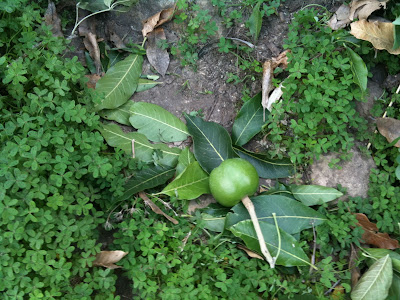Like the area to the left of the stairs it is already filled with mature plants. There are two big clumps of Agave attenuata, a large stand of yucca and the ubiquitous jade. There is also one narrow sliver of workable dirt right above the retaining wall. It's usually covered in grass and gopher mounds and the dirt was starting to overflow the wall.
I decided I could kill three birds with one garden. I could get rid of all the ugly grass, stabilize the loose dirt on the steep incline, and most importantly, plant things that I would be happy to see as I climb the stairs.

I started by digging out the top 6-10" of dirt to get rid of the weeds and bring the level down a little. This step actually took three weeks because I got rid of the dirt by filling up my trash and yard waste containers. I was afraid they would be too heavy for the truck to lift but they were always empty when I got home on trash day.
I managed to clear the space from the A. attenuatas to the stairs which still feels like my yard. I talked to my neighbor about extending it to the right into her yard and she's all for it. She'll support anything that reduces the amount of yard work she has to pay someone to do.
The next step was to select the plants. I've been collecting and hoarding plants for so long that I had a variety of things to choose from. I didn't want to buy anything, so I limited myself to plants that I had rescued, borrowed, scavenged or traded.

I had three nice cuttings of Aloe arborescens and a few pieces of a compact senecio.

A few pieces of Aloe nobilis

Some of my Agave potatorum pups from the plant that just bloomed.

This is a little rescue that I haven't identified yet. I'll check my Irish book to see if I can find it.
One of the Agave desmettiana that John gave me.
Oscularia deltoides from the garden of a friend's mom who moved to an assisted living center.

Everything is small now but several of the plants have the potential to get big. The arborescens can form a giant clump that will have beautiful orange flowers when it blooms. The Aloe nobilis can also form big clumps even if they aren't as high as the arborescens.

Nevertheless, I felt like the garden looked a little sparse. I went back though my collection and pulled out a few more plants that I thought could work. I still have a lot of A desmettiana. These grow fast and send out lots of offsets so I felt I could rely on this to fill in some space.
I'm also aware that I'm really heavy on the spiky rosettes. I guess that's what happens when your fixated on agaves. I decided to include this little euphorbia (I think) that my friend Bob gave me when I moved into my house. He got it when Metro was reclaiming the railroad tracks to build the Expo light rail line. A lot of the fallow tracks had plants like this growing on them. Bob's studio was a block away from tracks and he collected a lot of plants that would have been doomed otherwise. This one has been in a tiny pot for a few years so I expect it to take off once it gets established in the ground. It will make me happy to think of Bob when I see it.

Here in the second half of the garden you can see some of the additional plants. You can barely see the senecio cuttings and my little potatorums. I'm hoping that the senecio will eventually trail down the hill and over the wall and offer a blue counterpoint to all of the green going on. I tried to keep the spiky, pointy things higher on the hill so they won't be a hazard to people walking by.

I'm still thinking about some softer things that can go at the bottom. I'd love some rosemary to flow over the wall along with the Oscularia. I also need more low ground covers to discourage weeds and to offer more texture. I'm a little out of my element with that kind of stuff though so I may take a while to identify the right plants.











































